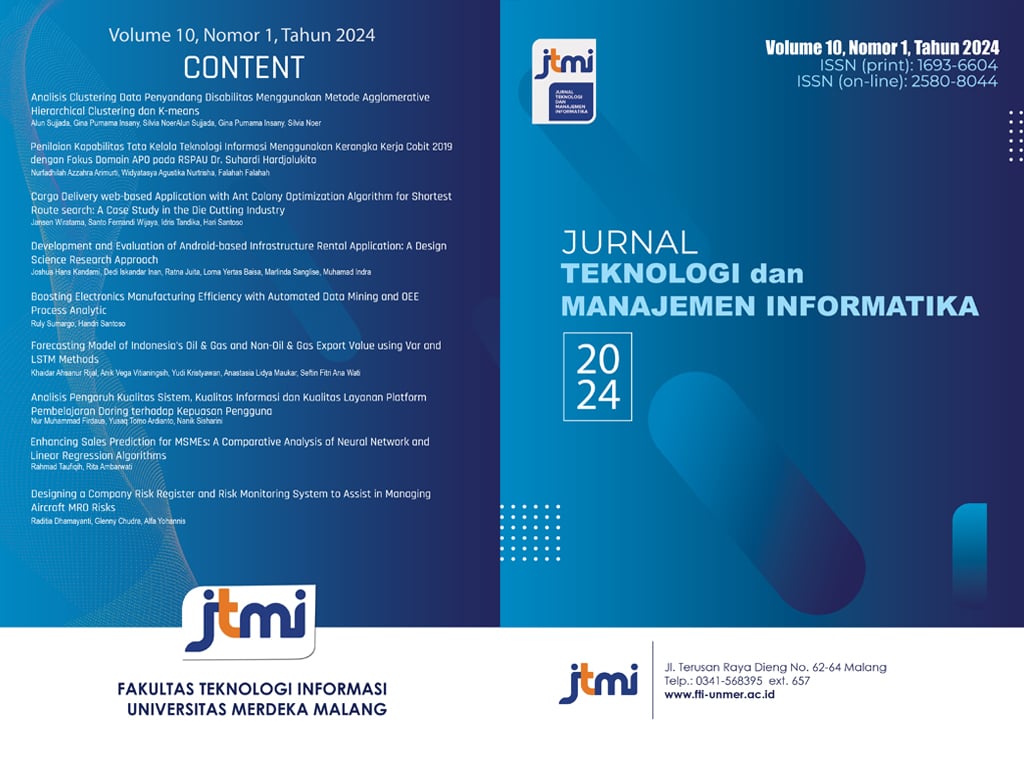Designing a Company Risk Register and Risk Monitoring System to Assist in Managing Aircraft MRO Risks
DOI:
https://doi.org/10.26905/jtmi.v10i1.12518Keywords:
Pengelolaan Risiko, Risk Register, Risk Monitoring, MRO,Abstract
This company specializes in maintenance, repair, and overhaul (MRO) services for aircraft. MRO activities are crucial to ensuring the safety and reliability of aircraft operations. However, these activities also involve various risks that can affect the performance and reputation of companies in multiple fields. To manage these risks effectively, a system for risk registration and monitoring has been designed for companies in the MRO industry. This paper presents the design of the Risk Register and Monitoring System, which includes the identification, assessment, and management of risks related to the activities of all existing units within companies in the MRO industry. This system is designed to provide a structured approach to risk management, which can help companies in the MRO industry manage risks across all units. The proposed system consists of several components, including automation for performing risk registers and monitoring through a website. This system allows companies in the MRO industry to assess the severity of risks, simplify risk management strategies, and streamline the risk registration process. As a result, companies in the MRO industry can minimize the impact of risks from each unit and enhance efficiency and effectiveness in risk managementDownloads
References
A. T. Sunardi. and E. Suprianto. (2015). Penanganan Heatexchanger (Material Repairable) pada Bagian Qality Inspection PT. X. Jurnal: Industri Elektro dan Penerbangan (INDEPT), 5(1), 12–16.
D. Rodrigues. and P. Lavorato. (2016). Maintenance, Repair and Overhaul (MRO) Fundamentals & Strategies: An Aeronautical Industry Overview. International Journal of Computer Applications, 135(12), 21–29, from doi: 10.5120/ijca2016908563.
H. Setiawan and C. Asmarawati. (2022). Perancangan Mitigasi Resiko Human Error Aktivitas Maintenance Pada Pt Batam Aero Technic. Computer and Science Industrial Engineering (COMASIE), 7(1), 8-17.
S. Nam., S. Choi., G. Edell., A. De., and W.-K. Song. (2023). Comparative Analysis of the Aviation Maintenance, Repair, and Overhaul (MRO) Industry in Northeast Asian Countries: A Suggestion for the Development of Korea’s MRO Industry. Sustainability, 15(2), from doi: 10.3390/su15021159.
NN. Auliaullah., W. Sutari., and S. A. Salma. (2021). Perancangan Treatment Risiko Pada Proses Produksi Pipa Baja Di Pt Xyz Menggunakan Pendekatan Risk Management Process Berdasarkan Iso 31000: 2018 Klausul 6.4 Untuk Memenuhi Persyaratan Iso 9001:2015 Klausul 6.1. e-Proceeding of Engineering, 8(5), 8457–8464.
M. Miftakhatun. (2020). Analisis Manajemen Risiko Teknologi Informasi pada Website Ecofo Menggunakan ISO 31000. Journal of Computer Science and Engineering (JCSE), 1(2), 129–146, from doi: 10.36596/jcse.v1i2.76.
S.O.D. Ningsih. and S.W. Hati (2019). Analisis Resiko Keselamatan Dan Kesehatan Kerja (K3) Dengan Menggunakan Metode Hazard and Operability Study (Hazop) Pada Bagian Hydrotest Manual Di Pt. Cladtek Bi Metal Manufacturing. Journal of Applied Business Administration, 3(1), 29–39, from doi: 10.30871/jaba.v3i1.1288.
A. H. Maritsa., U. Salsabila., M. Wafiq., P. R. Anindya., and M. Ma’shum. (2021). Pengaruh Teknologi Dalam Dunia Pendidikan. Al-Mutharahah: Jurnal Penelitian Dan Kajian Sosial Keagamaan, 18(2), 91–100, from doi: 10.46781/al-mutharahah.v18i2.303.
D. S. Budi., T.A.Y. Siswa., and H. Abijono. (2016). Analisis Pemilihan Penerapan Proyek Metodologi Pengembangan Rekayasa Perangkat Lunak. Teknika, 5(1), 24–31, from doi: 10.34148/teknika.v5i1.48.
A. Widarsono. and R. A. Saputra. (2012). Analisis Dan Perancangan Sistem Informasi Akuntansi Penerimaan Kas Ke Sekolah Dengan Menggunakan Metode System Development Life Cycle (SDLC). Jumal ASET (Akuntansi Riset), 4(2), 843-852, from doi: 10.17509/jaset.v4i2.8920.
R. Ilyas. and Y. Chisnanto. (2018). Pengembangan Sistem Informasi Penelitian LPPM Universitas Jenderal Achmad Yani Dengan Agile SDLC. Konferensi Nasional Sistem Informasi (KNSI), 974-979, Available: http://simlit.lppm.unjani.ac.id.
A. Parker., A. Heflin., and L.C. Jones. (2021). Analyzing University of Virginia Health publications using open data, Python, and Streamlit. Journal of the Medical Library Association : JMLA, 109(4), 688–689, from doi: 10.5195/jmla.2021.1360.
A.S. Oztas., E. Yemen., and E. Tuzun. (2018). Real-Time Monitoring and Control of The SDLC Process on a Single Automation in Core Banking Applications. International Conference on Advanced Technologies, Computer Engineering and Science (ICATCES’18), 104–108.
A. Alzayed. and A. Khalfan. (2022). Understanding Top Management Involvement in SDLC Phases. Journal of Software, 17(3), 87–120, from doi: 10.17706/jsw.17.3.87-120.
A.H.A. Kamal., C.C.Y. Yen., G. J. Hui., P. S. Ling. and Fatima-tuz-Zahra. (2020). Risk Assessment, Threat Modeling and Security Testing in SDLC. Available: http://arxiv.org/abs/2012.07226.
J. de V. Mohino., J.B. Higuera., J.R.B. Higuera., and J.A.S. Montalvo. (2019). The Application of a New Secure Software Development Life Cycle (S-SDLC) with Agile Methodologies. Electronics, 8(11), from doi: 10.3390/electronics8111218.
S. Pargaonkar. (2023). A Comprehensive Research Analysis of Software Development Life Cycle (SDLC) Agile & Waterfall Model Advantages, Disadvantages, and Application Suitability in Software Quality Engineering. International Journal of Scientific and Research Publications, 13(8), 120–124, from doi: 10.29322/ijsrp.13.08.2023.p14015.
Downloads
Published
Issue
Section
License
Copyright (c) 2024 Jurnal Teknologi dan Manajemen Informatika

This work is licensed under a Creative Commons Attribution-ShareAlike 4.0 International License.
Authors who publish with this journal agree to the following terms:
(1)Â Copyright of the published articles will be transferred to the journal as the publisher of the manuscripts. Therefore, the author confirms that the copyright has been managed by the journal.
(2) Publisher of JTMI: Jurnal Teknologi dan Manajemen Informatika is University of Merdeka Malang.
(3) The copyright follows Creative Commons Attribution–ShareAlike License (CC BY SA): This license allows to Share — copy and redistribute the material in any medium or format, Adapt — remix, transform, and build upon the material, for any purpose, even commercially.




